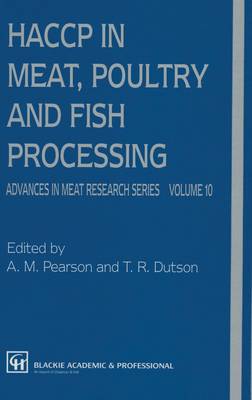
- Retrait en 2 heures
- Assortiment impressionnant
- Paiement sécurisé
- Toujours un magasin près de chez vous
- Retrait gratuit dans votre magasin Club
- 7.000.0000 titres dans notre catalogue
- Payer en toute sécurité
- Toujours un magasin près de chez vous
151,45 €
+ 302 points
Description
1 The origin and concept of HACCP.- 1.1 Introduction.- 1.2 Development of the HACCP concept.- 1.2.1 HACCP - A new approach.- 1.2.2 HACCP - A preventative system.- 1.3 Acceptance of HACCP by the food industry.- 1.3.1 Establishment of HACCP by other companies.- 1.3.2 Role of various agencies.- 1.4 Summary.- References.- 2 The HACCP system and how it fits into FSIS programs.- 2.1 Introduction.- 2.1.1 FSIS background.- 2.1.2 Industrial responsibility and HACCP.- 2.1.3 FSIS and HACCP.- 2.2 HACCP study.- 2.2.1 Background.- 2.2.2 Consultations and public hearings.- 2.2.3 Workshops.- 2.3 Critical control points for various models.- 2.3.1 Refrigerated foods (cooked and assembled) critical control points.- 2.3.2 Raw beef pattie critical control points.- 2.3.3 Whole young chickens critical control points.- 2.3.4 Cooked sausage critical control points.- 2.3.5 Pork slaughter market hogs critical control points.- 2.4 In-plant testing of HACCP models.- 2.4.1 Background.- 2.4.2 Plant specific plan.- 2.4.3 Inspection during phases II and III.- 2.4.4 Phase II: Implementation.- 2.4.5 Phase III: Operational.- 2.5 Evaluation.- 2.5.1 Background.- 2.5.2 Limitations.- 2.5.3 HACCP model checklist.- 2.5.4 National profiles.- 2.5.5 Quantitative plant data.- 2.5.6 Qualitative plant data.- 2.5.7 Inspector and plant personnel survey.- 2.5.8 Workshop evaluation.- 2.5.9 Training.- 2.5.10 In-plant changes.- 2.6 Current HACCP issues.- 2.6.1 Voluntary/mandatory.- 2.6.2 Review of HACCP plans.- 2.6.3 Transition period.- 2.6.4 Plan approval.- 2.6.5 Critical limits.- 2.6.6 Generic models.- 2.6.7 Training.- 2.6.8 Plan failure.- 2.6.9 Safety/economic.- 2.6.10 Other quality systems.- 2.6.11 Scientific validity.- 2.7 Quadrilateral discussions on food safety.- 2.7.1 Introduction.- 2.7.2 HACCP working group.- 2.7.3 HACCP working group report.- 2.8 Summary.- References.- 3 Implementation of HACCP program on farms and ranches.- 3.1 Introduction.- 3.2 Livestock quality assurance programs.- 3.3 Implementing HACCP on livestock units.- 3.3.1 Initiating on-farm HACCP preventive medicine programs.- 3.3.2 Hazard identification.- 3.3.3 Flow diagrams.- 3.4 Conclusion.- References.- 4 Implementation of the HACCP program by meat and poultry slaughterers.- 4.1 Introduction.- 4.2 Purpose of HACCP.- 4.2.1 Selection of team members.- 4.2.2 Training of HACCP team.- 4.3 Development of the HACCP program.- 4.3.1 Selection of the HACCP team coordinator.- 4.3.2 Development of the master HACCP program.- 4.4 Implementation of the HACCP program.- 4.4.1 Support of management.- 4.4.2 Fitting HACCP plan into operations.- 4.4.3 Focusing attention on hazards.- 4.4.4 Product specific HACCP programs.- 4.5 Summary.- References.- 5 The use of HACCP for producing and distributing processed meat and poultry products.- 5.1 Introduction.- 5.2 Reasons for using HACCP.- 5.3 Developing HACCP plans.- 5.4 Hazard analysis and risk assessment.- 5.4.1 Product recalls.- 5.4.2 Epidemiological data.- 5.4.3 Chemical hazards.- 5.4.4 Physical hazards.- 5.4.5 Biological hazards.- 5.5 Critical control points and critical limits.- 5.5.1 Formulating.- 5.5.2 Cooking.- 5.5.3 Cooling.- 5.5.4 Holding.- 5.5.5 Packaging.- 5.5.6 Preventing recontamination.- 5.5.7 Storing and distributing.- 5.6 Monitoring.- 5.7 Corrective action.- 5.8 Record keeping.- 5.9 Verification.- 5.10 Should HACCP be mandatory?.- 5.11 Summary.- References.- Addendum - Guideline for writing operating instructions/HACCP plans for processed meat and poultry products.- A.1 Headings.- A.2 Critical Control Point (CCP).- A.3 Control Point (CP).- 6 Implementation of the HACCP program by the fresh and processed seafood industry.- 6.1 Introduction.- 6.2 Significance of the seafood industry.- 6.2.1 Resources.- 6.2.2 Fishery habitats.- 6.2.3 US imports of fishery products.- 6.2.4 US exports of fishery products.- 6.2.5 Challenges facing the US seafood industry.- 6.2.6 Food safety in the US fishery system.- 6.3 HACCP in the seafood industry.- 6.3.1 Background.- 6.3.2 Bene...
Spécifications
Parties prenantes
- Auteur(s) :
- Editeur:
Contenu
- Nombre de pages :
- 412
- Langue:
- Anglais
- Collection :
Caractéristiques
- EAN:
- 9780751402292
- Date de parution :
- 31-12-95
- Format:
- Livre relié
- Format numérique:
- Genaaid
- Dimensions :
- 156 mm x 234 mm
- Poids :
- 752 g

Seulement chez Librairie Club
+ 302 points sur votre carte client de Librairie Club
Les avis
Nous publions uniquement les avis qui respectent les conditions requises. Consultez nos conditions pour les avis.






